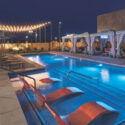
Today, CityCenter’s a reality: 66 acres of concrete, glass and steel in the heart of the Las Vegas Strip.
CityCenter had its roots in MGM Resorts International’s 2004 acquisition of the Mandalay Resort Group (the deal closed in 2005). The deal gave MGM Resorts an incredible swath of land between the Bellagio and Monte Carlo, land on which it could build a signature project that would redefine the company. From the start, MGM Resorts brass were clear that Project CityCenter—the development’s working name—would be something different.
At the November 9, 2004 press conference that unveiled the concept, then-CEO Terry Lanni said the CityCenter master plan represented “a significant new direction for our city and our company,” adding that it came at a time when the city was taking “the initial steps to becoming a major urban center in the western United States.”
At that press conference, MGM Resorts unveiled an idea more than a commodity. Only a few things were certain: Project CityCenter would be built on land between the Bellagio and Monte Carlo which the company had recently consolidated with its acquisition of Mandalay Resort Group. It would feature a 4,000-room casino resort, three smaller boutique hotel, and 1,650 condominium residences that would give the area a 24-hour, “city-like” ambience. The centerpiece was to have been an open-air shopping district—definitely not a mall—whose streets allowed both pedestrian and vehicular traffic.
In an interview with the Wall Street Journal, then-president and CFO Jim Murren said that the shopping would be a “SoHo-type” experience, a reference to the area of Manhattan south of Houston Street in which high-end boutiques and chain stores have generally pushed out artists’ lofts. Some within the company called it “SoBella,” for “south of Bellagio.”
“We’re creating our own urban environment,” he said, raising expectations that Project CityCenter would be very different from previous developments.
“It’ll be a city in and of itself here,” he said later. “Our economic responsibility is to make money for our shareholders and for our employees. Our social responsibility is to provide a greater array of cultural, educational and residential opportunities for our community. That’s the genesis of CityCenter.”
This wasn’t to be a typical Strip resort development at all, in fact, but an “urban village” that would stretch from the Strip to Frank Sinatra Drive: a city in three dimensions, and a mixed-use project with gambling.
Project CityCenter was slated to cost somewhere between $3 billion and $4 billion and, in its first year of operation, achieve an 18 percent return on investment.
After that initial press conference, MGM Resorts continued to plan the project and hire architects for its many components; this initial design phase, which took 20 months, saw the project begin to take shape. Less than a year later, the company was ready to announce the all-star lineup that would transform 66 acres of Las Vegas into a new, vertical development that many said was the future of Las Vegas.
On September 15, 2005, Lanni revealed key details of Project CityCenter. Its cost was now estimated at $5 billion, which made it the largest and most expensive private development in United States history. It was now to feature the flagship 4,000-room hotel as well as two non-gaming boutique hotels with 400 rooms and 200 condominium units each, two 500-unit condominium high-rises, and 140 residences incorporated into the retail district as brownstones and lofts attached to the shops.
Pelli Clarke Pelli, a firm helmed by American Institute of Architects Gold Medal recipient Cesar Pelli, won the commission to design the central hotel-casino. Pelli’s portfolio included the Petronias Towers, an iconic Kuala Lumpur structure that was, from its opening in 1998 until 2004, the highest building in the world (it remains the tallest twin-towers structure in the world), and Bloomberg Tower, a 55-story office and residential tower in midtown Manhattan. Certainly, this was an architect who knew how to get the most out of a building’s footprint.
MGM Resorts tapped Rafael Vinoly Architects to design the condominium-hotel towers, an element that ultimately became Vdara but which at this point was planned as two separate towers. Vinoly had recently completed Jazz at Lincoln Center, a New York performing arts complex, and the Kimmel Center, the home of the Philadelphia Orchestra.
The boutique hotel slated to have an international operator was to be designed by Kohn Pedersen Fox and Adam Tihany, while London-based architect Sir Norman Foster, whose numerous decorations included a barony and the prestigious Pritzker prize, was to design a hotel to be managed by the Light Group, the nightlife operator that at the time ran Light and Fix at Bellagio.
The general contractor, Perini Building, had already started work on the project, with the 5,300-space employee parking garage behind Bellagio getting under way in April.
At the time, Project CityCenter appeared to be the crest of an immense wave of development that would redefine Las Vegas: by October 2005, almost 50,000 luxury condominium units in 175 towers were planned throughout the city.
In January 2006, Boyd Gaming announced its own mixed-use project, Echelon Place, which would replace the Stardust with four hotels, a convention center and retail, but no condominiums. Boyd’s announcement came a week before the closure of the Boardwalk, the 300-room casino hotel that was in the middle of Project CityCenter’s footprint. Demolition began immediately, and before long the massive, grinning clown was torn down. Analysts remained bullish about growth; the concept of a mammoth Strip development was looking better and better.
Luxury Move
Things were looking so good that in February 2006 Murren announced that the project would be built bigger, to aim at a higher price point. The central 4,000-room casino resort, originally planned to be in the middle range of Strip hotels, would now be positioned as “the leading hotel project” in town, according to Murren.
The total costs for upgrading the casino resort, adding more residential space and building a monorail to run through the property’s heart pushed the estimated cost from $5 billion to $7 billion, with about $2.5 billion in expected residential sales. At a February 8 meeting, MGM Resorts’ board of directors approved the final design for CityCenter: the now-luxury casino hotel, two 400-room non-gaming hotels, 2.3 million square feet of residential units, and 470,000 square feet of entertainment, dining and retail.
Construction finally started on Project CityCenter shortly after midnight on Sunday, June 25, with the delivery of 10,000 cubic yards of concrete, used to pour the foundation of the Pelli-designed casino resort.
In October, MGM Resorts opened a preview center at the neighboring Bellagio, in which potential owners could learn more about the residential options at CityCenter and sign an interest list. They could choose from units at Vdara, a 1,543-unit condominium hotel adjacent to the Bellagio; 228 residences located above the 400-room Harmon hotel; 227 residences above the 400-room Mandarin Oriental hotel; and the Veer Towers, twin 37-story leaning high-rises, which would be exclusively condominium. Unit sizes ranged from 500 square feet to the 4,100-square-foot Mandarin Oriental penthouse. At $8 million, this was the most expensive residence at CityCenter, though costs for all units were expected to average more than $1,100 per square foot.
Around this time, MGM Resorts announced that the Light Group would operate the Harmon hotel. The Light Group came to Las Vegas in 2001, when its eponymous nightclub opened at the Bellagio. Today it operates more than a dozen nightclubs, lounges and restaurants at MGM Resorts properties, and it was hoped that the nightlife pioneers could bring their commitment to hip design to a signature property.
MGM Resorts was on a roll. In 2006, the company more than doubled its fourth-quarter net income, with visitation increasing and sales at Signature, the condominium development behind MGM Grand, bringing in higher-than-expected revenues. Potential buyers couldn’t line up fast enough to sign contracts for CityCenter condos, with Mandarin nearly sold out and reservations placed on the majority of Veer and Vdara units by February, potential buyers putting down $15,000 each to reserve their units. With Mandarin Oriental sales averaging $1,584 a square foot, the company’s earlier optimism seemed justified.
Tragedy struck the project on February 6, 2007, when two 3,000-pound walls collapsed and killed construction workers Bobby Lee Tohannie and Angel J. Hernandez. Two other workers were injured in the accident and, coming on the heels of an incident at the Orleans casino that led to the deaths of two building engineers, raised concerns over safety at Las Vegas job sites.
But construction continued, and with the economic picture getting brighter by the day, one CityCenter was no longer enough; in April, the company paid $575 million for two parcels of land at the north end of the Strip, adjacent to its Circus Circus casino hotel. Totaling 34 acres, they included the site of the Strip’s first casino resort, the El Rancho Vegas. MGM Resorts floated plans to parlay the new acquisition with the land under Circus Circus’ RV park and low-rise motel, giving the company 78 acres on which to build another massive development.
MGM Resorts’ first-quarter results made earlier projections seem, if anything, too conservative. Buoyed by rising room rates and the strong performance of its restaurants and nightclubs—elements that CityCenter was to heavily rely on—the company had recorded sales of $1.1 billion on $2.7 billion worth of condos, and net income for the quarter jumped by nearly 17 percent.
By the spring of 2007, CityCenter was simply one of several new construction projects on the Strip. Price tags ranged from $7.4 billion for CityCenter to $1.8 billion for the Palazzo, under construction next to the Venetian. Other projects included Boyd’s Echelon (5,000 rooms, $4.4 billion), the Cosmopolitan, wedged between Bellagio and CityCenter (3,000 rooms, $3 billion), the Fontainebleau (3,900 rooms, $2.9 billion), Steve Wynn’s Encore (2,000 rooms, $2.1 billion) and the Plaza, a 3,500-room, $5 billion version of the New York City landmark, which was to rise on the site of the Frontier casino.
El Ad Properties, the company that was developing the Plaza, had paid more than $33 million per acre for Strip land—a record that spoke to the unbounded confidence in the Strip’s future.
With nearly 29,000 new rooms in developments costing $26.6 billion, it wasn’t just MGM Resorts that was betting big on Las Vegas. With visitation and revenues climbing, there were few public concerns voiced about possible over-building; after all, skeptics had insisted the Strip was overbuilt in 1989, when Las Vegas had 67,000 hotel rooms. In mid-2007, Las Vegas was on its way to attracting a record number of visitors—more than 39 million. MGM Resorts’ Strip hotels boasted an occupancy rate of 98 percent that spring. It seemed foolish not to build as many rooms as possible. By the time the company disclosed its second-quarter results, half of the CityCenter condos had sold, for a total of $1.4 billion. With its buildings not even a third completed, the project already looked like a sure winner.
Around this time, CityCenter’s footprint got bigger, though without any acquisitions. A project that had been touted as 66 acres expanded to 76 acres, with MGM Resorts brass now including the 10-acre Bellagio employee garage in their count.
Gathering Storm
Yet, there were problems. In August, Harvey Englander, a construction worker, was killed in an accident while working on the central casino hotel. This was the third worker killed on the project, and while Clark County officials and MGM Resorts expressed their confidence in the site’s safety, it cast a pall. The death of a fourth worker, Harold Billngsley, in October, after another accident, highlighted concerns about the project’s scale and pace.
There were other clouds appearing on the horizon. An article in the August 18, 2007 Wall Street Journal for the first time used the phrase “credit crunch” in connection with Las Vegas, suggesting that the planned $2 billion expansion of the Tropicana had become a victim of tightening credit markets. Though CityCenter was not thought to be in any danger, this was the first real sign that perhaps not everyone was as confident in the Strip’s future as they had once been.
But MGM Resorts found a partner who was as sanguine about Las Vegas as the company itself; on August 21, it announced that Dubai World, the investment vehicle for the Persian Gulf emirate, would pay $5.1 billion for 50 percent ownership in CityCenter and a 9.5 percent stake in MGM Resorts itself. The deal was trumpeted as giving MGM Resorts cash for future developments and reducing debt, and it indicated the increasingly global profile of Las Vegas.
In one move, the company both reduced its debt and gained access to a lengthy list of wealthy international clients. For Dubai World’s part, this was simply the latest in a real estate and hospitality buying spree that saw the investment company buy such notable brands as Barney’s, a New York department store; and the QE2, perhaps the world’s best-known ocean liner.
In October, MGM Resorts announced that the total cost of CityCenter was increasing to $7.8 billion, thanks to an unexpected increase in the amount of concrete and steel needed for the project. By the end of the fourth quarter, the estimated cost had risen again, to somewhere between $8.1 and $8.4 billion. By the following summer, the reported cost would hit $9.2 billion.
Despite the rising costs, at the start of 2008, the residential portion of CityCenter still looked golden. By early January, 93 percent of the Mandarin Oriental’s 227 residences had sold; 42 percent of the 1,543 at Vdara; 60 percent at the Veer Towers; and more than a third of the Harmon’s residences were snapped up in an exclusive “friendly and family” pre-sale offering. But around this time, the bloom came off the Las Vegas Strip condo market. The Cosmopolitan, a condo/hotel project adjacent to CityCenter, received a notice of default in January, and ultimately ended up in the hands of Deutsche Bank, its primary lender.
Safety continued to be a concern. In April, electrician Mark Wescoat died after a fall, and in June, Dustin Tarter, who had been working on a moving crane, perished in an accident. Tarter’s death, the sixth in 16 months, sparked a strike, after negotiations about project safety broke down. After a single day, the strike ended, with union representatives proclaiming an understanding with general contractor Perini. Yet safety remained an issue, highlighted by the termination of several construction workers in August, after photographs of them drinking at bars across the Strip before clocking in for work were published in a local newspaper.
By the summer, it was clear that Las Vegas was no longer “recession-proof,” as some had suggested. Declining gaming revenues, slumping visitation and plummeting room rates made it clear that the city was not immune to the larger economic slowdown. In August, Boyd Gaming halted work on its Echelon development, citing difficulties in lining up financing as well as the souring economy. While this was one less competitor for CityCenter, it also signaled a declining confidence in the Strip’s growth.
At this stage, MGM Resorts brass made a conscious decision not to make any dramatic changes in the project to accommodate the shifting economic realities.
“We had to be careful not to change too much,” Jim Murren explained in a February interview. “We would have lost ourselves. We decided not to build in phases. How could you do that with a project like this? It just doesn’t work.”
Murren said that compromising on the quality of materials was never a question, but adjusted to the market by changing the nature of venues within the project and lowering the price points at restaurants and bars.
“Design and construction changes were almost non-existent,” he said. “If we could finish on time, and with quality, we knew we’d be OK.”
Mounting Challenges
But that wasn’t a sure thing. Suddenly, the hardest part of finishing the project became getting the money, as lenders and Wall Street analysts began expressing skepticism about the company’s potential to secure the financing needed to complete CityCenter. Yet in this regard MGM Resorts was fortunate. That August, the company secured a total of $2.3 billion for construction. Though that was $700 million short of the total needed, company president Jim Murren was confident that all financing would be in place.
Also in August, MGM Resorts announced that, though Perini would remain CityCenter’s general contractor, Tishman Construction would be taking a $250 million contract to oversee construction at the Harmon. This attracted little notice at the time, but in the following month news of considerable problems at the Harmon site became public.
In September, the public learned that, in July, engineers for Halcrow Yolles, the engineer of record for CityCenter, had discovered serious problems at the Harmon. Pacific Coast Steel, a Perini subcontractor, had incorrectly installed link beams—concrete with reinforced metal bar (rebar) placed horizontally over doors on hotel floors—on 15 of the existing 22 stories of the building. Because of conflicts between the structural drawings and the realities of actual construction, rebar was incorrectly spaced; in some cases, when steel extended out of the finished floor, workers cut the rebar.
This incorrect installation affected the building’s ability to weather sideways stresses, such as high winds and earthquakes. Compounding the initial mistakes, inspectors for Converse Consultants, the third-party inspection firm tasked with discovering precisely this kind of error, submitted a total of 62 falsified reports, which erroneously verified that construction was proceeding according to plan. Ultimately, Pacific Coast Steel was fined for its workmanship issues, and Converse Consulting was temporarily banned from taking on new projects in the area.
The biggest consequence of the errors, however, was that the Harmon was capped at 28 stories, and its condo portion would disappear.
Some counted the cancellation of the Harmon condos as a blessing in disguise, since Palms Place and the Trump International, two recent Strip corridor condo projects, were having difficulty closing buyers. With credit tightening across the country and Las Vegas property values in freefall, it became difficult to obtain financing for units in high-rise towers; as a result of the slowdown in condo sales and the generally gloomy outlook for Las Vegas, Fitch Ratings Service downgraded MGM Resorts’ outstanding debt in October to junk grade.
In the third quarter, the company’s profits fell 67 percent, underlining concerns about Las Vegas. The company announced that it was indefinitely tabling a “CityCenter East” Atlantic City development and the north Strip project, and looked to secure the final $1.2 billion in financing it would need to finish CityCenter.
In November, MGM Resorts Chairman and CEO Terry Lanni stepped down, citing the challenges the company was facing, and the need for a “younger person” to confront them. President and COO Jim Murren was promoted to fill Lanni’s roles.
By January of 2009, the company had taken several steps to improve the project’s finances. By delaying the Harmon’s completion and cutting other costs, MGM Resorts lowered the CityCenter price tag by $800 million.
In December, the company sold its Treasure Island casino to billionaire Phil Ruffin for $775 million, easing concerns about over-leveraging. Yet while the project remained on track and Vdara and Aria, the newly named casino hotel, began accepting reservations, finance problems continued to dog the project.
In March, MGM Resorts came close to shutting down CityCenter after a tentative loan agreement with Deutsche Bank fell through. A default, which might have triggered a bankruptcy reorganization for the entire company, threatened to derail CityCenter.
Even as doubts about the company’s viability intensified, senior lenders gave it some much-needed breathing room, in the form of an extension on its loan requirements. Its partner, Dubai World, filed a lawsuit claiming that MGM Resorts’ mismanagement put the project at risk. On March 27, MGM Resorts narrowly avoided a CityCenter shutdown when it made a $200 million funding payment.
A month later, MGM Resorts and Dubai World reached a rapprochement with each other and lenders. At last, CityCenter’s finances were in order. In May, additional corporate restructuring helped to improve MGM Resorts’ long-term financial future, and guaranteed that CityCenter would open as scheduled.
From there, it was a short walk to the first sneak previews, and ultimately the opening of Vdara, Mandarin Oriental and Aria in December 2009. The opening fireworks no doubt masked several sighs of relief. After four years, and plenty of drama, the future of Las Vegas was open at last.
In the end, Murren said, CityCenter was more than a collection of buildings.
“It’s a symbol of courage for people who didn’t give in,” he said. “It’s about the resiliency of this community; it’s a symbol of hope. Las Vegas will rise again, that day is approaching. CityCenter will be the beacon that brings us there.”












